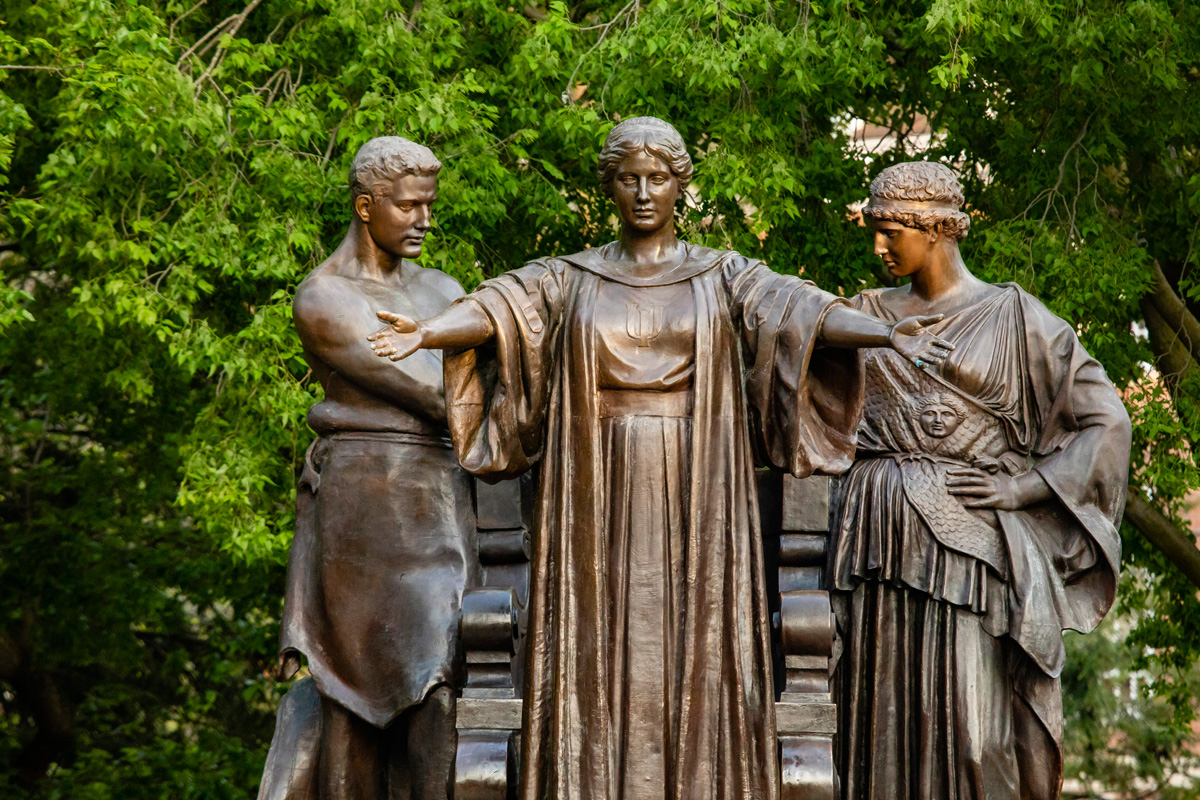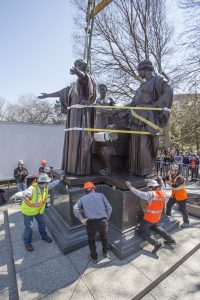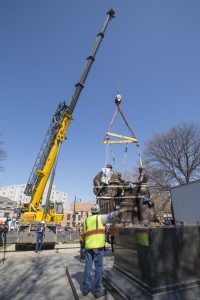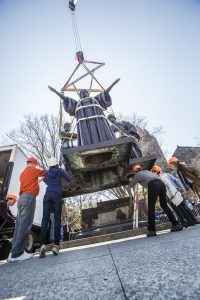Alma Mater Conservation
The Alma Mater sculpture underwent a complete conservation process in 2014, including laser cleaning, bolt replacement, and joint filling.

The full restoration of the University of Illinois sculpture group entitled Alma Mater was conducted by Conservation of Sculpture & Objects Studio (CSOS) of Forest Park, Illinois. The studio was selected through the Request for Proposal process administered by the University of Illinois Purchasing Division. The restoration took place at the studio’s 13,000-square-foot facility.
The removal of the sculpture was supervised by CSOS, while Methods & Materials Inc. and Custom Service Crane prepared, lifted, and transported the sculpture. Alma Mater was removed from its granite base and transported to the CSOS facility on Tuesday, August 7, 2012.
The sculpture is comprised of a group of four bronze elements:
- Alma Mater, “Our Mother,” a standing woman with out-stretched arms welcoming her children.
- “Labor,” a standing iron worker wearing a leather apron.
- the klismos (throne) behind Alma Mater.
- and “Learning,” a young classically draped modification of Athena Lemnia.
The sculpture incorporates the University’s motto, “Learning and Labor.” The Alma Mater stands 13 feet tall atop a granite base, cast in 30 sections by American Art Bronze Foundry and Jules Berchem and Sons of Chicago, then bolted together.
After spending over 600 days in Forest Park, the University’s iconic Alma Mater statue returned home on April 9, 2014. F&S employees played a crucial role in the process. F&S architect and planner James R. Lev coordinated the project for the Capital Programs Division, alongside Melvyn A. Skvarla, the campus historic preservation officer. F&S staff involved in the project included movers, operators, transportation workers, iron workers, mill workers, and electrical workers. Facilities Information Resources (FIR), Procurement Services, and Customer Relations & Communications also contributed to the project.


 “Aside from the conservation work itself, we had very little anticipation of the minor, yet crucial, tasks that would
“Aside from the conservation work itself, we had very little anticipation of the minor, yet crucial, tasks that would
be needed to remove the statue from the site and put it back in place when the conservation work was completed,”
Lev said. “We didn’t always know ahead of time what would be needed, and we often needed assistance at short notice.
When we asked for help, we always got what we needed, when we needed it.”
Some of the work completed by F&S staff included the removal (and subsequent replacement) of bollards (short metal posts) to allow crane and truck access. They also created and installed steel plates to cover the center of the granite base while the statue was removed. Additionally, iron workers drilled and epoxied anchors into the granite to secure brass angles designed to prevent Alma Mater from sliding off the base during seismic activity. Movers installed fencing to protect the worksite during the removal and reinstallation process, and they brought in bleachers for the public to use while watching the statue’s return.
FIR, mill workers, and iron workers were also pivotal in developing a Virtual Alma Mater infrastructure, enabling graduates to pose for pictures with a 3D image at the pedestal during the 2013 Commencement weekend.
“It has become apparent to me that the staff totally understands this community’s attachment to this sculpture,”
Lev said. “The Alma Mater is a campus icon that connects past generations with future generations. Everyone who has touched this preservation of our history should share in the sense of accomplishment and a job very well done.”